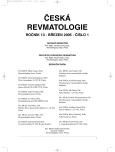Combined involvement of CNS and pituitary gland as a primary manifestation of Wegener’s granulomatosis
Authors:
R. Špíšek 1; E. Kolouchová 2; J. Jenšovský 3; R. Rusina 4; J. Plas 5; J. Bartůňková 1
Authors‘ workplace:
Ústav imunologie, Univerzita Karlova, lékařská fakulta a Fakultní nemocnice Motol, Praha
1; Alergologická a imunologická ambulance, Benešov
2; Odd. klinické endokrinologie a Osteocentrum, Ústřední vojenská nemocnice, Praha-Střešovice
3; Neurologická klinika, Fakultní Thomayerova nemocnice, Praha-Krč
4; Neurochirurgická klinika UK 1. LF, Ústřední vojenská nemocnice, Praha-Střešovice
5
Published in:
Čes. Revmatol., 13, 2005, No. 1, p. 29-32.
Category:
Case Report
Overview
Wegener granulomatosis is a systemic vasculitis of small and medium vessels. It predominantly affects upper and/or lower respiratory airways and kidneys and its pathogenesis is not fully understood. WG relatively frequently affects the nervous system (in 30-50% according to the different studies). The most frequently it manifests as necrotizing vasculitis that leads to the peripheral neuropathies or to the cranial nerves palsy. Impairment of the central nervous system is less frequent and occurs in 2-8 % of patients. Three major pathogenetic mechanisms are described: CNS vasculitis, spreading of granulomas from the adjacent anatomical areas (paranasal cavities, orbit etc.) and new formation of granulomas in brain tissue. This case report describes patient, in whom WG manifested in the form of localized skin involvement and combined CNS involvement which included pituitary gland. Atypical presentation of WG impedes and slows down the process of diagnosis and emphasises the need for collaboration between medical specialists.
Key words:
Wegener granulomatosis, case report, diabetes insipidus, panhypopituitarism, CNS
Labels
Dermatology & STDs Paediatric rheumatology RheumatologyArticle was published in
Czech Rheumatology

2005 Issue 1
Most read in this issue
- Potential therapeutic approaches in polymyositis and dermatomyositis
- Chlamydia trachomatis and Chlamydophilla pneumoniae antibodies in a cohort of rheumatic patients
- Combined involvement of CNS and pituitary gland as a primary manifestation of Wegener’s granulomatosis
- Relevance of anti-nucleosome antibodies detected by enzyme – based immunoassays in lupus diagnosis. Comparative analysis of three commercial kits
